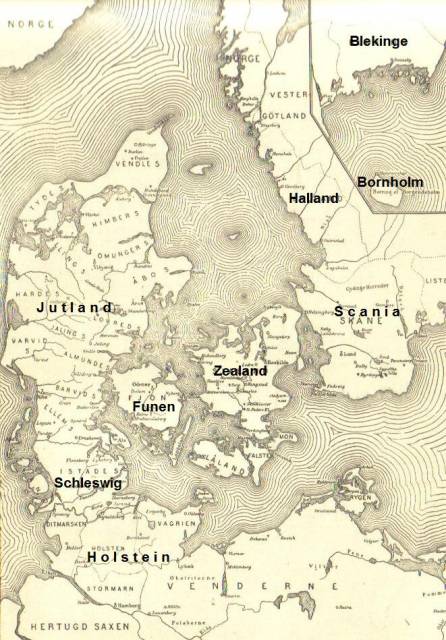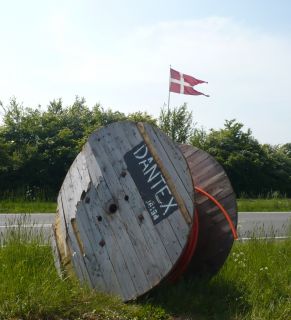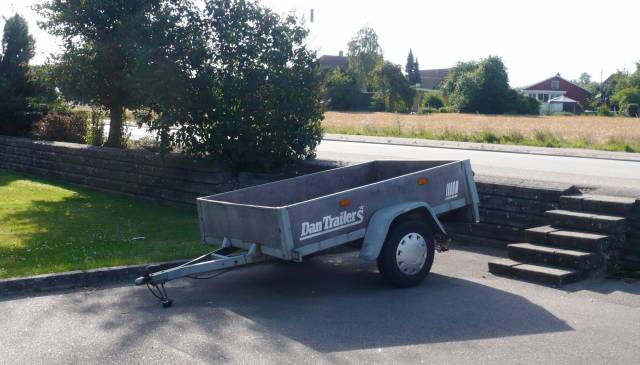Danes and Jutes: Dan and Judah-Dan
By Mikkel Stjernholm Kragh
The modern Danish people (Danskere) is made up of the proper Danes (Daner) on the numerous islands, and the Jutes (Jyder) on the Jutland peninsula, if recent immigrants, etc., are ignored. The original Danes were a Nordic tribe, while the original Jutes were a Germanic tribe. The Danes are of Dan, and the Jutes are of Judah and Dan.
The deportation of Israel to areas south of the Caucasus
The three northern tribes of Israel – Dan, Asher, and Naphtali – were among the first of the Israelite tribes to be deported out of the land of Canaan, because the invaders who attacked and deported the Israelite tribes – the Assyrians and Babylonians – invaded the land of Canaan from the north. From 734 to 732 BC Tiglath-Pileser III King of Assyria invaded and conquered the northern, eastern, and western parts of the 10 tribed northern kingdom of Israel, as the Holy Scriptures record:
”In the days of Pekah king of Israel came Tiglath-pileser king of Assyria, and took Ijon, and Abel-beth-maachah, and Janoah, and Kedesh, and Hazor, and Gilead, and Galilee, all the land of Naphtali, and carried them captive to Assyria.” (2 Kings 15:29)
In 724 BC Salmaneser V King of Assyria attacked Samaria, the capital of the northern 10 tribed kingdom of Israel, and in 721 BC his successor, Sargon II, took Samaria, and the rest of the 10 tribes of Israel were deported to areas south of the Caucasus mountains and south of the Caspian Sea, as the Holy Scriptures record:
”In the ninth year of Hoshea the king of Assyria took Samaria, and carried Israel away into Assyria, and placed them in Halah and in Habor by the river of Gozan, and in the cities of the Medes.” (2 Kings 17:6)
These areas are almost identical to the areas where the oldest Norse chronicles state that the ancestors of the Nordic and Germanic tribes came from, before they trekked over Eastern Europe to Northern Europe.
The Aser and Vaner homeland south and north of the Caucasus
The Icelandic chief and historian Snorre Sturlasson (1179-1241) wrote Heimskringla (app. 1230), of which the first part is called the Ynglinge Saga, wherein Sturlasson describes the homeland of the Nordic and Germanic tribes as the areas south and north of the Caucasus mountains. They were divided into two groups, Aser and Vaner, which obviously are the names of Asher and Dan, two of the Israelite tribes in the camp of Dan.
Snorre Sturlasson describes the homeland of the Vaner, which was the lost Israelite tribe of Dan:
“On the south side of the mountains which lie outside of all inhabited lands runs a river through Swithiod, which is properly called by the name of Tanais, but was formerly called Tanaquisl, or Vanaquisl, and which falls into the Black Sea. The country of the people on the Vanaquisl was called Vanaland, or Vanaheim; and the river separates the three parts of the world, of which the eastermost part is called Asia, and the westermost Europe.” (Snorre Sturlasson: Ynglinge Saga pt. 1)
The river Tanakvisl/Vanakvisl/Tanais must be the river Don, because its ancient Greek name was Tanaïs. In the Old Testament, the Danites named places after their ancestor Dan (Judges 18:12, 29), and Don also carries the name Dan.
The Vaner lived adjacent to the Aser, whose chief was Odin:
”The country east of the Tanaquisl in Asia was called Asaland, or Asaheim, and the chief city in that land was called Asgaard. In that city was a chief called Odin, and it was a great place for sacrifice. It was the custom there that twelve temple priests should both direct the sacrifices, and also judge the people. They were called Diar, or Drotner, and all the people served and obeyed them. Odin was a great and very far-travelled warrior, who conquered many kingdoms, and so successful was he that in every battle the victory was on his side.” (Snorre Sturlasson: Ynglinge Saga pt. 2)
The lost tribes of Israel’s trek from the Middle East to Northern Europe
After a war between the Aser and Vaner, which ended without anyone of them prevailing, Odin led the tribes to Northern Europe:
”There goes a great mountain barrier from north-east to south-west, which divides the Greater Swithiod from other kingdoms. South of this mountain ridge it is not far to Turkland, where Odin had great possessions. In those times the Roman chiefs went wide around in the world, subduing to themselves all people; and on this account many chiefs fled from their domains. But Odin having foreknowledge, and magic-sight, knew that his posterity would come to settle and dwell in the northern half of the world. He therefore set his brothers Ve and Vilje over Asgaard; and he himself, with all the gods and a great many other people, wandered out, first westward to Gardarike [Russia], and then south to Saxland [Saxony]. He had many sons; and after having subdued an extensive kingdom in Saxland, he set his sons to rule the country. He himself went northwards to the [Baltic] sea, and took up his abode in an island which is called Odin’s Island [Odense] on Funen.” (Snorre Sturlasson: Ynglinge Saga pt. 5, my brackets)
The account of this trek is confirmed by important historians such as Peter Friderich Suhm (Denmark, 1728-1798) and Olof Rudbeck the Elder (Sweden, 1630-1702). Suhm and Rudbeck did not trace our origins all the way back to the Israelites, but Suhm did write - speaking of the Nordic peoples - that
“the ancestors of us, the Germans, and the Celts lived together in Asia Minor” (P.F. Suhm: Om Odin og den Hedniske Gudelære og Gudstieneste udi Norden (1771), p. 140-141)
The Norwegian explorer Thor Heyerdahl also confirmed Snorre Sturlasson’s account in 2002, when he published Jakten på Odin (The Search for Odin), wherein Heyerdahl specifically wrote that the ancestors of the Norsemen came from Azerbaijan.
The many Odins
There were several Odins. Suhm writes of at least three different Odins. Odin was most likely not a name, but a title, which meant something like “lord, chief, no. one or prime minister”.
In Russian, Odin means “one”. I have asked a Russian lady about this, and she confirmed it.
The lost tribes of Israel are divided in two groups
When the lost tribes, led by Odin, came to the Baltic Sea, they divided themselves into two groups. One group went north across the Baltic Sea and became the ancestors of the Nordic tribes, such as the Danes (Daner), Swedes (Svear), Geats (Götar), and Norwegians. The other group went west across what today is Poland and became the ancestors of the Germanic tribes.
Suhm thus writes that it is
“reasonable that our fathers have come here via Russia and the eastern part of Poland. When they came to the Baltic Sea and present-day Livonia, they divided themselves into two great multitudes. The one went north, and our fathers descend from them, and the other went west, and became the ancestors of many German peoples” (P.F. Suhm: Historie af Danmark, Vol. 1 (1782), p. 4-5)
Denmark called Vanaheim
After the tribes had arrived in Northern Europe, Vanaheim - the homeland of the Vaner - was still a geographical place. Suhm mentions a Swedish King Svedger in the 1st century AD who went to Vanaheim and married a Vaner woman, and then continued to Germany, the Greater Svithjod and Gothheim, to search for the old Odin, who had been missing for five years. (P.F. Suhm: Om Odin og den Hedniske Gudelære og Gudstieneste udi Norden (1771), p. 99)
From the context, it seems that by Vanaheim is meant Denmark.
The original Danes and Jutes
The Gothic historian Jordanes writes in De origine actibusque getarum (The origin and deeds of the Goths, 551 AD) that the Danes came out of the Swedes. (The original Swedes and the Geats later formed Sweden.) The Danes were of the tribe of Dan, who came to the Scandinavian peninsula along with the other tribes of Bilhah and Zilpah, Naphtali, Asher, and Gad.
The original Jutes, on the other hand, were of the tribe of Judah, who along with other tribes of Leah made up the Germanic tribes that settled on the European continent and the Jutland peninsula.

Above: Denmark in the Middle Ages. The two eastern provinces Blekinge and Bornholm are inserted in the upper right corner. (From A. Fabricius: Illustreret Danmarkshistorie for Folket Vol. 1 (1914), p. 539)
Origin of the nation of Denmark
Suhm writes that around 235 AD Dan Mikillati, king of the Danes in Scania and Halland, was also crowned as king of the islands Zealand, Funen, Møn, Falster, and Lolland. When the Jutes and the Angles were invaded by the Saxons, Dan Mikillati succesfully helped them, and for this the Jutes and the Angles also crowned him as king in Viborg in Jutland (P.F. Suhm: Historie af Danmark (1782), p. 103-112).
Denmark, as we know it today, was thus united, even though the three parts – Scania Land, the isles, and Jutland – kept their separate laws. (The four provinces Scania, Halland, Blekinge, and Bornholm were collectively called Scania Land (Terra Scaniæ).)
The name Danmark (Denmark)
Danmark – the Danish name for Denmark - means “the Danes’ borderland”, because “mark” meant borderland. Danmark was originally the name for Dan Mikillati’s kingdom in Scania and Halland, but eventually became the name of the entire kingdom.
The Danish historiographer Iver Nielsen Hertzholm (1635-1693) wrote that the Danes’ and Denmark’s name comes “from the Hebrew word Dan: meaning to judge, investigate, and believes that we are called so because of our wisdom” (according to P.F. Suhm: Critisk Historie af Danmark (1774), p. 144).
In the days of the Old Testament, the tribe of Dan had a habit of naming places after their father Dan, the son of Israel. Dan originally lived in a territory next to Ephraim, Benjamin, Judah and the Philistines. In the early 12th century 600 Danites sought a new territory in the north of Canaan, where there lived Phoenicians, next to Naphtali and the half tribe of Manasseh in Bashan. On their way, they camped in a place in Judah, which the Danites called Mahaneh-dan, meaning “Camp of Dan”:
“And there went from thence of the family of the Danites, out of Zorah and out of Eshtaol, six hundred men appointed with weapons of war. And they went up and pitched in Kirjath-jearim, in Judah: wherefore they called that place Mahaneh-dan unto this day: behold, it is behind Kirjath-jearim.” (Judges 18:11-12)
After they had smitten the peaceful Phoenicians of Laish with the sword and burned the city, they called the new city Dan:
“And they built a city, and dwelt therein. And they called the name of the city Dan, after the name of Dan their father, who was born unto Israel: howbeit the name of the city was Laish at the first.” (Judges 18:28-29)
When the tribe of Dan, called Vaner and Taner, trekked across Eastern Europe, they likewise seem to have named several major rivers after themselves. The river Don, by the ancient Norsemen called Tanakvisl and Vanakvisl, and by the ancient Greeks called Tanaïs, has already been mentioned. Other major East European rivers with the prefix D-n are: Donets, a tributary to Don. Dnieper, which by late Greek and Roman authors was called Danapris and Danaper respectively. Dniestr, which by the Romans and Jordanes (6th century AD) was called Danastris and Danastus. The Danube, which in German, Danish, and other languages is called Donau.
In 1219 King Valdemar II of Denmark led a succesfull crusade in Estonia to convert the Estonians to the Christian faith. Besides King Valdemar and the Danish army, the Crusaders also included Archbishop Sunesen of Denmark, Bishop Theodorik of Estonia, a German army, and a Slavonic Sorb army. The Crusaders encamped at Lyndanisse and began to build a castle which they called Dane Castle (Castrum Danorum), which became the city Tallinn, which in Estonian means Dane City, and today is the capital of Estonia. (It was at the battle of Lyndanisse that a flag – which probably had belonged to some of the Crusaders and had gotten hurled up in the air - fell down from the sky, and became Dannebrog, the Danish flag.)
Today Danes likewise have a habit of using the name Dan in their firms. If you type in “Dan” in the Danish online yellow pages (see here), there comes out a long list of firms, such as:

Above: Cable tubes made by Dantex.
Dantex – they make cable tubes and other tubes
Dan-Ejendomme – they rent out apartments
Dan-Glas – there are several firms by this name, they are into car windows
Dan-Tæk – they thatch roofs (with straws)
Rota-Dan – they make different kinds of wheels
Dan-Color – they produce different kinds of paints
Dan Dryer – they produce dryers for bathrooms
Dan-markering – they make road signs and other forms of road markings
DanTrailers - they make trailers for cars

Above: a trailer from DanTrailers
Dan Delektron – they produce lightning conductors
Nor-Dan Bus – a Norwegian-Danish bus company
Dan Cargo – a leading Nordic firm within international transport and third-party logistics
Dan-cool – they make vehicles with refrigerators and freezers (for butchers, for example)
Dan-Labels – they make labels
Dan Stål – there are numerous firms by this name that makes products with steel and other metals

Advodan - a firm of lawyers (advocates)
Baby Dan – they develop, produce, and sell safety equipment for children age 0-5
Dan Auto Parts – they sell auto parts
Danfoss – they make thermostates and other products
Dan Group Alarm – they set up alarms

Above: a property with alarms from Dan Group Alarm
The Jutes
The Jutes were originally a Germanic tribe which later became Nordic. (See P.F. Suhm: Historie af Danmark, Vol. 1 (1782), p. 26 and 109, and P.F. Suhm: Critisk Historie af Danmark, Vol. 1 (1774), p. 172-173, and here.) The Jutes came to Jutland from Germany, while the Danes came to the isles from the Scandinavian peninsula. The Angles and the Saxons, two other Germanic tribes, settled in the southern parts of the Jutland peninsula.
Today the descendants of the ancient Germanic tribes are dispersed throughout both Germanic speaking and non-Germanic speaking peoples, though. The following European nations are in the following percentages genetically descended from the ancient Germanic tribes:
Germany: 25% Germanic, 45% Celtic, 20% Slavonic, 10% Jewish
Austria: 35% Germanic, 30% Slavonic, 10% Finno-Ugric, 10% Phoenician, 10% Jewish, 5% Celtic
Switzerland: 30% Germanic, 55% Celtic, 10% Jewish, 5% Slavonic
Netherlands: 40% Germanic, 50% Celtic, 10% Viking
Belgium: 20% Germanic, 80% Celtic
UK: 13% Germanic, 75% Celtic, 12% Viking
France: 20% Germanic, 70% Celtic, 10% Phoenician
Czech Republic: 50% Germanic, 42% Slavonic, 8% Jewish
Spain: 15% Germanic, 40% Celtic, 30% Iberian, 7% Phoenician, 7% “special case” (?), 1% Arab
Sweden and Norway: 12% Germanic, 88% Viking
Denmark: 40% Germanic, 60% Viking
(See the entire list here.)
When Denmark today genetically is 60% similar to the ancient Vikings and 40% similar to the ancient Germanic tribes, the Israelite tribe of Dan must make up the 60% Viking part and the Judah-Jutes must make up the 40% Germanic part.
Jutes invade England
Even though the Jutes had become a part of Denmark under King Dan Mikillati app. 235 AD, Jutland remained the apple of discord between Danes and Saxons, and to such an extent that the Jutes often were reckoned as belonging to the latter rather than the former. (P.F. Suhm: Historie af Danmark, Vol. 1 (1782), p. 109)
In the 5th century AD, when the earth in Jutland was exhausted and could not support the population, the Jutes invaded England along with the Angles and the Saxons. In these invasion are not mentioned any Danes. The Danes and the Norwegians only invaded the British Isles in the later Viking Era (8th to 11th century).
The tribe of Dan in the book of Revelation
The tribe of Dan’s future is shrouded in mystery.
The tribe of Dan is, as the only tribe of Israel, not among the sealed 144,000 male Israelites(Rev. 7:4-8) that are going to reign with the Lamb and God. Revelation does simply not state why the tribe of Dan is not among the 144,000.
The 144,000 are the co-rulers and are compared with the fruitsfruits (Rev. 14:4). The firstfruits was a small ceremonial offering at Pentecost (Ex. 34:22, Lev. 23:15-17). All the inhabitants of the coming Kingdom of God are, on the other hand, compared with the normal harvest (Luke 10:2). The normal harvest takes place in the autumn, and is immensely larger than the firstfruits in size.
That the tribe of Dan is not among the 144,000 does therefore not mean that the tribe of Dan is going to perish.
May 2009
Bibliography
Authorized King James Version of the Bible
Adam Fabricius: Illustreret Danmarkshistorie for Folket, Vol. 1 (Copenhagen and Oslo: Gyldendalske Boghandel, Nordisk Forlag, 1914)
Snorri Sturlasson: Heimskringla or the Chronicles of the Kings of Norway translated by Samuel Laing (London, 1844) Mikkel Stjernholm Kragh has made a few corrections to the English translation. (Online version here.)
Peter Friderich Suhm: Critisk Historie af Danmark, udi den Hedenske Tid, fra Odin til Gorm den Gamle, Vol. 1(Critical History of Denmark, out in the Heathen Times, from Odin until Gorm the Old)(Copenhagen: Brødrene Johann Christian & Georg Christopher Berling, 1774) (Online here.)
Peter Friderich Suhm: Historie af Danmark, Vol. 1 (Copenhagen: Brødrene Berling, 1782) (Online here.)
Peter Friderich Suhm: Om Odin og den Hedniske Gudelære og Gudstieneste udi Norden (Copenhagen: Brødrene Berling, 1771)
Hjem/Home Artikler/Articles |